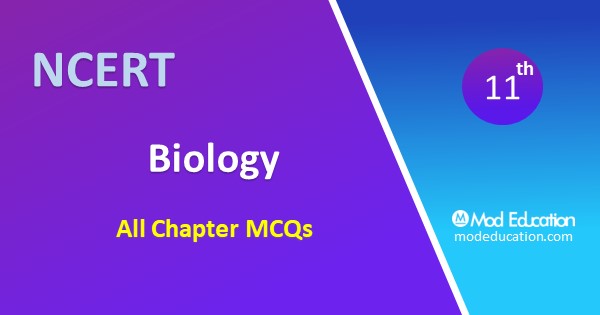MCQ questions for class 11 biology chapter 22 : MCQs Questions for Class 11 Biology chapter 22 Chemical Coordination and Integration with Answers PDF Free Download prepared here according to the latest CBSE RBSE ans other State Board syllabus and NCERT curriculum. Students can practice CBSE Class 11 Biology MCQs Multiple Choice Questions for all Chapter.

MCQ questions for class 11 biology chapter 22 NEET Chemical Coordination and Integration with answer Free PDF Download | NEET MCQ
Q1. In the mechanism of action of a protein hormone, one of the second messengers is
(a) Gastrin
(b) Cyclic AMP
(c) T3
(d) Insulin
(b) Cyclic AMP
Q2. Myopia is a defect in human eyes in which the image is formed:
(a) Behind retina and can be corrected by using convex lens
(b) Behind retina and can be corrected by using concave lens
(c) Infront of retina and can be corrected by using concave lens
(d) Infront of retina and can be corrected by using convex lens
(c) Infront of retina and can be corrected by using concave lens
Q3. BMR is increased due to:
(a) Sympathetic nervous system
(b) Adrenaline
(c) Parasympathetic nervous system
(d) Thyroxine
(d) Thyroxine
Q4. Transmission of light into nerve impulse is a:
(a) Mechanical process
(b) Physical process
(c) Chemical process
(d) Biochemical process
(b) Physical process
Q5. Steroid hormones easily pass through the plasma membrane by simple diffusion because they
(a) Are water-soluble
(b) Are lipid-soluble
(c) Enter through pores
(d) Contain carbon and hydrogen
(b) Are lipid-soluble
Q6. The vitamin which works along with para thyroid hormone is:
(a) Vitamin C
(b) Calciferol
(c) Tocopherol
(d) Vitamin – B12
(b) Calciferol
Q7. Parathormone regulates:
(a) Blood calcium level
(b) Calcium phosphate level
(c) Body temperature
(d) None of the above
(a) Blood calcium level
Q8. In Hashimoto’s disease symptoms develop like :-
(a) Hyposecretion of thyroxine
(b) Hyper secretion of thyroxine
(c) Hyposecreation of adrenaline
(d) None of the above
(a) Hyposecretion of thyroxine
Q9. Injection of which of the following increases metabolic rate :-
(a) STH
(b) Insulin
(c) Thyroxine
(d) Testosterone
(c) Thyroxine
Q11. Meibomian gland are associated with:
(a) Eyes
(b) Ears
(c) Reproductive organ
(d) Skin
(a) Eyes
Q12. The thyroid gland is homologous to which part of lower chordates :-
(a) Neural gland
(b) Pharyngeal gill pouch
(c) Nerve cord
(d) Endostyle
(d) Endostyle
Q13. The ‘islets of Langerhans’ are found in
(a) Alimentary canal
(b) Stomach
(c) Liver
(d) Pancreas
(d) Pancreas
Q14. If thyroid is removed from tadpole of frog, it will:
(a) Die soon
(b) Remains tadpole throughout life
(c) Grows in to giant frog
(d) Grows into dwarf frog
(b) Remains tadpole throughout life
Q15. Cochlea of mammalian ear is concerned with:
(a) Balancing of body
(b) Hearing
(c) Pereception of atmospheric pressure
(d) Both (a) and (b)
(b) Hearing
Q16. Which of the following is anvil shaped ear ossicle:
(a) Incus
(b) Malleus
(c) Stapes
(d) Humerus
(a) Incus
Q17. In children, hypothyroidism (underactive thyroid gland) can lead to __
(a) Goiter
(b) Acromegaly
(c) Cretinism
(d) Myxedema
(c) Cretinism
Q18. Diurnal rhythm of the body is maintained by
(a) melatonin
(b) isthmus
(c) PTH
(d) norepinephrine
(a) melatonin
Q19. Which hormone inhibits the release of growth hormone?
(a) Insulin
(b) Gonadotrophin
(c) Somatostatin
(d) Thymosin
(c) Somatostatin
Q20. Which of the following is essential for thyroid gland?
(a) NaCl
(b) I3
(c) CaCO2
(d) H2CO3
(b) I3
Q21. By the stimulation of which structure of human ear, the sound waves are perceived by brain :-
(a) Basilar membrane
(b) Tectorial membrane
(c) Meissner’s membrane
(d) Sensory hair cells of organ of corti
(d) Sensory hair cells of organ of corti
Q22. Which one of the following is not a second messenger in hormone action?
(a) Calcium
(b) cAMP
(c) cGMP
(d) Sodium
(d) Sodium
MCQ Questions for Class 11 Biology with Answers Chapter Wise PDF Download
MCQ Questions of Class 11 Biology with Answers Pdf will guide students to do a quick revision for all chapter.
- MCQs questions for class 11 biology chapter 1 The Living World
- MCQs questions for class 11 biology chapter 2 Biological Classification
- MCQs questions for class 11 biology chapter 3 Plant Kingdom
- MCQs questions for class 11 biology chapter 4 Animal Kingdom
- MCQs questions for class 11 biology chapter 5 Morphology of Flowering Plants
- MCQs questions for class 11 biology chapter 6 Anatomy of Flowering Plants
- MCQs questions for class 11 biology chapter 7 Structural Organisation in Animals
- MCQs questions for class 11 biology chapter 8 Cell: The Unit of Life
- MCQs questions for class 11 biology chapter 9 Biomolecules
- MCQ questions for class 11 biology chapter 10 Cell Cycle and Cell Division
- MCQ questions for class 11 biology chapter 11 Transport in Plants
- MCQ questions for class 11 biology chapter 12 Mineral Nutrition
- MCQ questions for class 11 biology chapter 13 Photosynthesis in Higher Plants
- MCQ questions for class 11 biology chapter 14 Respiration in Plants
- MCQ questions for class 11 biology chapter 15 Plant Growth and Development
- MCQ questions for class 11 biology chapter 16 Digestion and Absorption
- MCQ questions for class 11 biology chapter 17 Breathing and Exchange of Gases
- MCQ questions for class 11 biology chapter 18 Body Fluids and Circulation
- MCQ questions for class 11 biology chapter 19 Excretory Products and their Elimination
- MCQs questions for class 11 biology chapter 20 Locomotion and Movement
- MCQs questions for class 11 biology chapter 21 Neural Control and Coordination
- MCQ questions for class 11 biology chapter 22 Chemical Coordination and Integration
NCERT MCQ Questions for Class 11 Chemistry with Answers
PDF Free Download for Telegram
